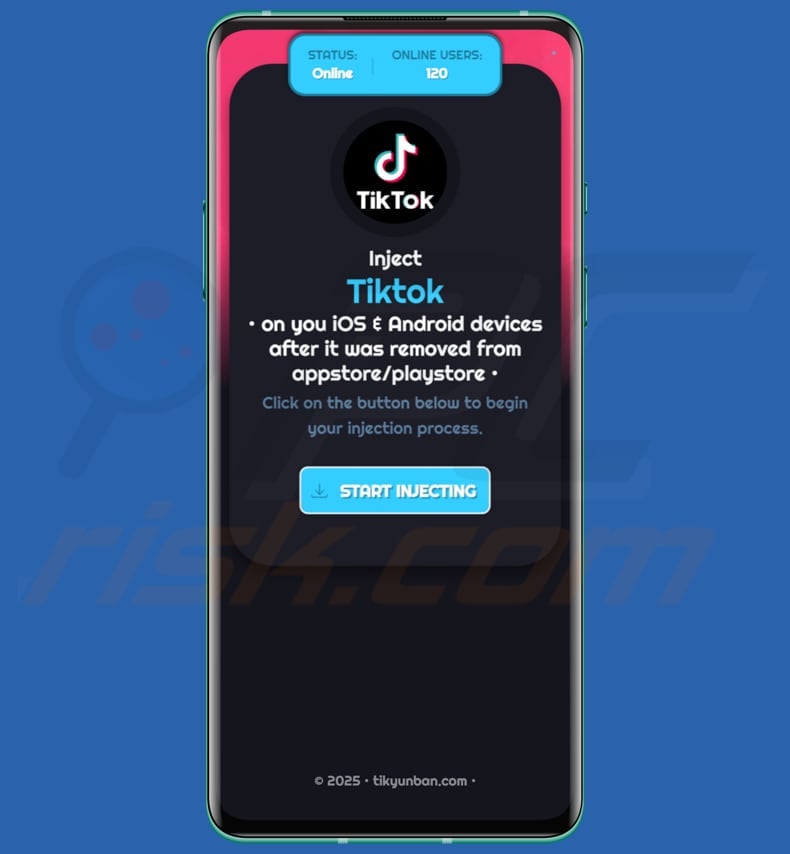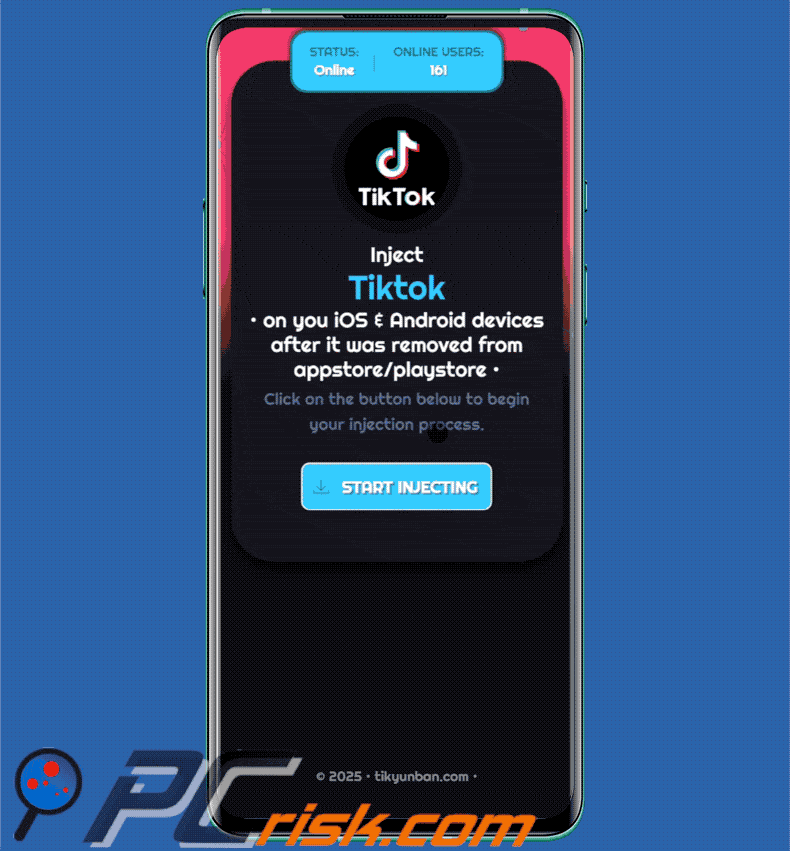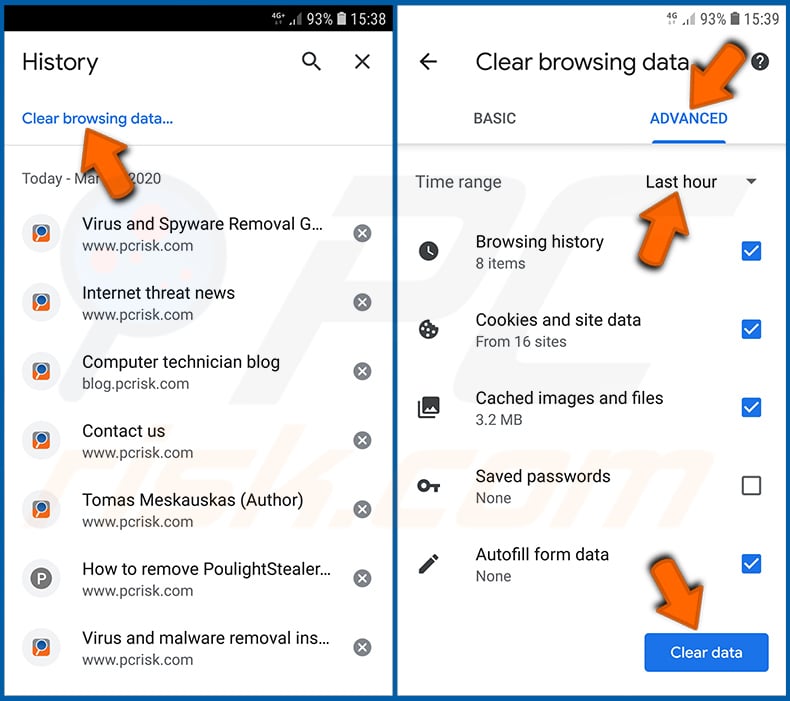How to identify scams like "Inject TikTok Scam"
Phishing/ScamAlso Known As: Inject TikTok fake website
Get free scan and check if your device is infected.
Remove it nowTo use full-featured product, you have to purchase a license for Combo Cleaner. Seven days free trial available. Combo Cleaner is owned and operated by RCS LT, the parent company of PCRisk.com.
What kind of scam is "Inject TikTok"?
We have inspected the scam and concluded that it is a scheme crafted to lure unsuspecting users into believing they can use the website to "inject" TikTok. However, this scam does not provide any real "TikTok injection" and is used to exploit users. Anyone encountering such a website should avoid interacting with it.

"Inject TikTok" scam overview
This scam was created to take advantage of the situation regarding the TikTok ban and the uncertainty around its availability. Since TikTok is removed from major app stores, many users are looking for other ways to get the app. Scammers saw an opportunity to exploit this situation by offering fake solutions, like "TikTok injection".
However, instead of allowing users to bypass restrictions, this scam leads users to other shady websites promoting unreliable and potentially malicious apps. The apps promoted by these sites may ask for unnecessary permissions, such as access to contacts, camera, or location, which can lead to privacy breaches.
Some of these apps could also be used for data collection. They might target personal details, like email addresses, IP addresses, browsing history, names, surnames, phone numbers, etc. The harvested details could be used for identity theft or sold to third parties. Additionally, the apps might lead to more serious security threats.
For example, they could expose users to other scams, where they would be encouraged to pay for "premium features" or to make in-app purchases that do not provide any real value. In some cases, these apps could install malicious software on the device without the user's knowledge and cause even more damage.
Overall, falling for the "TikTok injection" scam can lead to serious consequences, such as unauthorized access to social media accounts, identity theft, and financial losses. Users should be careful when encountering offers to download illegal content and banned apps to avoid the associated risks.
| Name | Inject TikTok fake website |
| Threat Type | Android malware, malicious application, unwanted application. |
| Related Domain | tikyunban[.]com |
| Detection Names | Trustwave (Phishing), Full List (VirusTotal) |
| Symptoms | The device is running slow, system settings are modified without user's permission, questionable applications appear, data and battery usage is increased significantly, browsers redirect to questionable websites, intrusive advertisements are delivered. |
| Distribution methods | Fake websites, unwanted apps, malicious online advertisements, social engineering. |
| Damage | Stolen personal information (private messages, logins/passwords, etc.), decreased device performance, battery is drained quickly, decreased Internet speed, huge data losses, monetary losses, stolen identity (malicious apps might abuse communication apps). |
| Malware Removal (Windows) |
To eliminate possible malware infections, scan your computer with legitimate antivirus software. Our security researchers recommend using Combo Cleaner. Download Combo CleanerTo use full-featured product, you have to purchase a license for Combo Cleaner. 7 days free trial available. Combo Cleaner is owned and operated by RCS LT, the parent company of PCRisk.com. |
Conclusion
In conclusion, this scam tricks users into thinking they can get the TikTok app but leads them to shady websites and potentially malicious apps. Falling for it can put their devices, privacy, and personal data at risk, so it is important to avoid suspicious sites and only use official sources (official pages or app stores).
How did unwanted application infiltrate my device?
Unwanted apps are distributed through various channels to trick users into installing them. Scammers may create fake websites that appear legitimate, encouraging users to download the apps. Unofficial app stores, third-party downloaders, Peer-to-peer (P2P) networks, and free file hosting sites can also be used to distribute these unwanted apps.
Additionally, fake software updates are a common tactic, where users are convinced to download and install an update that is actually a harmful app. In other cases, unwanted apps are bundled with other programs, and users agree to install them if they do not reject unwanted offers during installations.
How to avoid installation of unwanted apps?
Always download software from trusted sources like official app stores or websites. When installing, choose "Custom" or "Advanced" options to review and decline any additional software or offers. Never trust pop-ups and ads on questionable web pages or notifications from websites of this kind.
Do not click links in suspicious emails or messages. Regularly update your device (installed apps and the operating system) and use reliable security software.
Appearance of Inject TikTok scam (GIF):

Quick menu:
- Introduction
- How to delete browsing history from the Chrome web browser?
- How to disable browser notifications in the Chrome web browser?
- How to reset the Chrome web browser?
- How to delete browsing history from the Firefox web browser?
- How to disable browser notifications in the Firefox web browser?
- How to reset the Firefox web browser?
- How to uninstall potentially unwanted and/or malicious applications?
- How to boot the Android device in "Safe Mode"?
- How to check the battery usage of various applications?
- How to check the data usage of various applications?
- How to install the latest software updates?
- How to reset the system to its default state?
- How to disable applications that have administrator privileges?
Delete browsing history from the Chrome web browser:

Tap the "Menu" button (three dots on the right-upper corner of the screen) and select "History" in the opened dropdown menu.

Tap "Clear browsing data", select "ADVANCED" tab, choose the time range and data types you want to delete and tap "Clear data".
Disable browser notifications in the Chrome web browser:

Tap the "Menu" button (three dots on the right-upper corner of the screen) and select "Settings" in the opened dropdown menu.

Scroll down until you see "Site settings" option and tap it. Scroll down until you see "Notifications" option and tap it.

Find the websites that deliver browser notifications, tap on them and click "Clear & reset". This will remove permissions granted for these websites to deliver notifications. However, once you visit the same site again, it may ask for a permission again. You can choose whether to give these permissions or not (if you choose to decline the website will go to "Blocked" section and will no longer ask you for the permission).
Reset the Chrome web browser:

Go to "Settings", scroll down until you see "Apps" and tap it.

Scroll down until you find "Chrome" application, select it and tap "Storage" option.

Tap "MANAGE STORAGE", then "CLEAR ALL DATA" and confirm the action by taping "OK". Note that resetting the browser will eliminate all data stored within. This means that all saved logins/passwords, browsing history, non-default settings and other data will be deleted. You will also have to re-login into all websites as well.
Delete browsing history from the Firefox web browser:

Tap the "Menu" button (three dots on the right-upper corner of the screen) and select "History" in the opened dropdown menu.

Scroll down until you see "Clear private data" and tap it. Select data types you want to remove and tap "CLEAR DATA".
Disable browser notifications in the Firefox web browser:

Visit the website that is delivering browser notifications, tap the icon displayed on the left of URL bar (the icon will not necessarily be a "Lock") and select "Edit Site Settings".

In the opened pop-up opt-in the "Notifications" option and tap "CLEAR".
Reset the Firefox web browser:

Go to "Settings", scroll down until you see "Apps" and tap it.

Scroll down until you find "Firefox" application, select it and tap "Storage" option.

Tap "CLEAR DATA" and confirm the action by taping "DELETE". Note that resetting the browser will eliminate all data stored within. This means that all saved logins/passwords, browsing history, non-default settings and other data will be deleted. You will also have to re-login into all websites as well.
Uninstall potentially unwanted and/or malicious applications:

Go to "Settings", scroll down until you see "Apps" and tap it.

Scroll down until you see a potentially unwanted and/or malicious application, select it and tap "Uninstall". If, for some reason, you are unable to remove the selected app (e.g., you are prompted with an error message), you should try using the "Safe Mode".
Boot the Android device in "Safe Mode":
The "Safe Mode" in Android operating system temporarily disables all third-party applications from running. Using this mode is a good way to diagnose and solve various issues (e.g., remove malicious applications that prevent users you from doing so when the device is running "normally").

Push the "Power" button and hold it until you see the "Power off" screen. Tap the "Power off" icon and hold it. After a few seconds the "Safe Mode" option will appear and you'll be able run it by restarting the device.
Check the battery usage of various applications:

Go to "Settings", scroll down until you see "Device maintenance" and tap it.

Tap "Battery" and check the usage of each application. Legitimate/genuine applications are designed to use as low energy as possible in order to provide the best user experience and to save power. Therefore, high battery usage may indicate that the application is malicious.
Check the data usage of various applications:

Go to "Settings", scroll down until you see "Connections" and tap it.

Scroll down until you see "Data usage" and select this option. As with battery, legitimate/genuine applications are designed to minimize data usage as much as possible. This means that huge data usage may indicate presence of malicious application. Note that some malicious applications might be designed to operate when the device is connected to wireless network only. For this reason, you should check both Mobile and Wi-Fi data usage.

If you find an application that uses a lot of data even though you never use it, then we strongly advise you to uninstall it as soon as possible.
Install the latest software updates:
Keeping the software up-to-date is a good practice when it comes to device safety. The device manufacturers are continually releasing various security patches and Android updates in order to fix errors and bugs that can be abused by cyber criminals. An outdated system is way more vulnerable, which is why you should always be sure that your device's software is up-to-date.

Go to "Settings", scroll down until you see "Software update" and tap it.

Tap "Download updates manually" and check if there are any updates available. If so, install them immediately. We also recommend to enable the "Download updates automatically" option - it will enable the system to notify you once an update is released and/or install it automatically.
Reset the system to its default state:
Performing a "Factory Reset" is a good way to remove all unwanted applications, restore system's settings to default and clean the device in general. However, you must keep in mind that all data within the device will be deleted, including photos, video/audio files, phone numbers (stored within the device, not the SIM card), SMS messages, and so forth. In other words, the device will be restored to its primal state.
You can also restore the basic system settings and/or simply network settings as well.

Go to "Settings", scroll down until you see "About phone" and tap it.

Scroll down until you see "Reset" and tap it. Now choose the action you want to perform:
"Reset settings" - restore all system settings to default;
"Reset network settings" - restore all network-related settings to default;
"Factory data reset" - reset the entire system and completely delete all stored data;
Disable applications that have administrator privileges:
If a malicious application gets administrator-level privileges it can seriously damage the system. To keep the device as safe as possible you should always check what apps have such privileges and disable the ones that shouldn't.

Go to "Settings", scroll down until you see "Lock screen and security" and tap it.

Scroll down until you see "Other security settings", tap it and then tap "Device admin apps".

Identify applications that should not have administrator privileges, tap them and then tap "DEACTIVATE".
Frequently Asked Questions (FAQ)
What is the purpose of an unwanted application?
Apps of this type can be designed for various purposes. They can be used to steal personal data, display intrusive ads, track user activity, push fake or unnecessary in-app purchases, and more.
Is an unwanted application legal?
Usually, unwanted applications are considered legal because their End User License Agreements (EULA) usually inform users about their potential behavior. As for TikTok, the app remains legal in many countries, but its status is uncertain in some regions, especially in the United States, due to national security concerns.
Is having an unwanted app installed on my computer dangerous?
It depends on the app's capabilities and purpose. However, in general, an unwanted app can compromise security and privacy, slow down the system, introduce harmful software, or cause other issues.
Will Combo Cleaner help me remove unwanted applications?
Yes, Combo Cleaner can help remove unwanted applications by scanning your system for various threats, including malware, adware, and other potentially harmful software, and removing them. It is worth noting that manual removal might be difficult. So, it is advisable to use specialized tools to remove unwanted apps and other threats.
Share:

Tomas Meskauskas
Expert security researcher, professional malware analyst
I am passionate about computer security and technology. I have an experience of over 10 years working in various companies related to computer technical issue solving and Internet security. I have been working as an author and editor for pcrisk.com since 2010. Follow me on Twitter and LinkedIn to stay informed about the latest online security threats.
PCrisk security portal is brought by a company RCS LT.
Joined forces of security researchers help educate computer users about the latest online security threats. More information about the company RCS LT.
Our malware removal guides are free. However, if you want to support us you can send us a donation.
DonatePCrisk security portal is brought by a company RCS LT.
Joined forces of security researchers help educate computer users about the latest online security threats. More information about the company RCS LT.
Our malware removal guides are free. However, if you want to support us you can send us a donation.
Donate
▼ Show Discussion